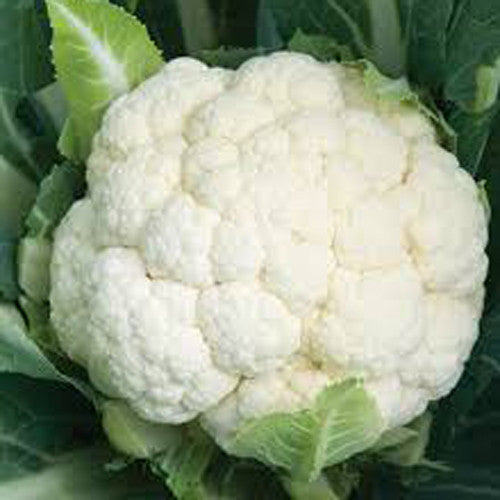Brassica oleracea
Origin
Northeast Mediterranean
Family
Brassicaceae
Description
Cauliflower is one of the many cabbage related cole crops that revels in cool weather. It has a very distinct nuttiness, closer to broccoli in flavor. The main edible part of both cauliflower and broccoli is the flower bud, making them both edible flowers.
Cauliflower is not the easiest vegetable to grow, because it is very sensitive to temperature changes, however with a little TLC, it can be a very rewarding vegetable.
The white varieties need to be blanched, by covering the head with its leaves. Cauliflower has thick & oval leaves which have a pronounced mid-rib and veins. The leaves and stem of cauliflower are both edible.
The cauliflower head is composed of tightly packed flower buds, often referred to as curds. The size of the head will depend on the variety you are growing, but average between 6 to 12 in.
The actual flowers of the cauliflower are the familiar 4 petals in a cross shape that give this family of vegetables the name cruciferous.
Environment
Plants will grow best in full sun, although a little partial shade might prevent plants from bolting or budding (forming small, button-sized heads), in warmer weather.
Plant the seeds ½ to ¾ inches deep. The rows should be 3 to 6 inches (7.6 to 15 cm.) apart, with a maximum of eight seeds per 1 foot (30 cm.) of row. If the plant bed starts to overcrowd, thin the plants to 1 inch (2.5 cm.) apart in the row.
Cauliflower needs fertile, well-drained, moist soil with plenty of rich organic matter. The soil pH should be between 6.5 and 6.8 for optimum growth and to discourage clubroot disease.
Add nitrogen-rich amendments such as cottonseed meal, or composted manure to the soil.
Harvesting
Most cauliflower varieties require about 2 months to mature, although some are a little quicker and others can take up to 3 months. Since they will not form heads in warm weather and can only handle a light frost, be sure to choose a variety that will have enough time to mature in your climate. That means a fast maturing variety if your spring or fall is short. Longer-maturing varieties are good choices for gardeners with mild or late winters. Gardeners in cold climates often have better luck putting out transplants in mid to late summer and harvesting in the fall.
Harvest when the heads reach the desired size and while the buds are still tight. Don't leave them too long, or the flowers will open. It would be better to cut them when mature and freeze them for later use. Another option is to lift the whole plant and store it, roots, stem and all intact, in a cool, dry place













